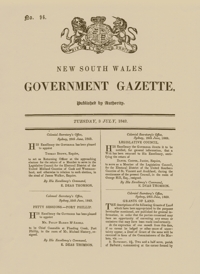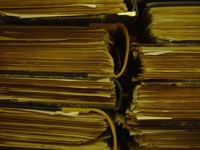Australian Government Gazettes – Have You Discovered Them?
If you are researching your Australian ancestors, one record that doesn’t get the recognition that it deserves is Government Gazettes. I know it has the word “government” in it, so it automatically “sounds” boring, but trust me the Government Gazettes are a truly fascinating read! And if you haven’t discovered them, now is a good time to do so.
I know I shouldn’t call them ‘Australian Government Gazettes’ as technically they’re not, but for ease of understanding, I’m choosing to.
First up, a little background history on them …
These Gazettes were first issued in the 1800s, by the governments of the various Australian colonies (this was way before Federation, as we didn’t have States then), and used the Government Gazettes as a means of communication to the general public.
They’re kind of like a newspaper, but without the whole journalism style we get these days. Instead they contained lots of facts (names, dates, places and events). These were generally issued one a week, but from time to time “Extraordinary Issues” or “Supplements” were released in between if there was a need.
What information is in an Australian Government Gazette?
The first question that everyone asks is “what will I find in them?” which as you would expect if a very valid question. The answer however isn’t as simple, as it tends to vary between the different Australian colonies, and between the years as well, but I won’t go into the nitty gritty as Archive Digital Books Australasia has done their own analysis on this, which you can read. However some information tends to be the same no matter what Australian colony, and no matter what timeframe, such as:
– Land transactions: records of land purchased, who by, who from, how much, and where
– Government Appointments: the person’s name, the new position and where
– Insolvency and Bankruptcy: these notices give a whole host of details
– Tenders for public works: roads, bridges, schools, halls etc (includes winning tenders too)
– Lists of licences: you’ll often get auctioneers, publicans, storekeepers, marriage celebrants and more
Other fascinating bits that you can find from time to time in them are:
– convict notices
 – absconders
– absconders
– petitions
– electoral registrars
– next of kin notices
– private notices
– patent applications
– cattle and horse brands
– dissolution of business partnerships
– unclaimed letters
– deserters and missing people
– requests for information
– lists of druggists and chemists
– impoundments
– notices of events
– lists of rations for government institutions (ie. prisons, asylums)
– rates of passengers
– deaths in public places
the list is endless … but you get the idea.
Until relatively recently the only way to gain access to the Australian Government Gazettes was to go to your State Library or Archives who held a copy, and look through the enormous original bound volumes page-by-page. However thanks to Archive Digital Books Australasia (formerly Archive CD Books Australia) you now have access to these on your computer at home on CD-ROM, annnnd … they’re fully searchable.
What years are available? And can I see a sample?
There a whole heap of years available, just click on the links below for each state to see what has been reproduced, and each has a sample you can click on to see the type of information in them.
New South Wales sample / listing
Queensland sample / listing
South Australia sample / listing
Tasmania sample / listing
Victoria sample / listing
Western Australia (see below)**
 ** The Western Australian Government Gazettes can be viewed on the State Law Publisher site. These cover the period 1935 through until 2011. To view them, use the Next and Previous buttons up the top, and if you click on the blue arrows, you can see images of the actual pages.
** The Western Australian Government Gazettes can be viewed on the State Law Publisher site. These cover the period 1935 through until 2011. To view them, use the Next and Previous buttons up the top, and if you click on the blue arrows, you can see images of the actual pages.
If you prefer your data online as opposed to on CD, you can find some Government Gazettes covering most states on Findmypast.com.au, and Ancestry.com.au has some for New South Wales only.
If you’d like to read more indepth descriptions about the Australian Government Gazettes, you can do so with articles that are on the Unlock The Past website. These cover the New South Wales, Queensland, South Australia and Victorian Gazettes.
And if you’re interested in current day Australian Government Gazettes, the place to visit is australia.gov.au.
So if you’ve done the BDM records, the immigration records, the military records and of course the cemeteries, try the Government Gazettes, as they really do contain an enormous amount of information, much of which you just won’t find anywhere else.






Leave a Reply